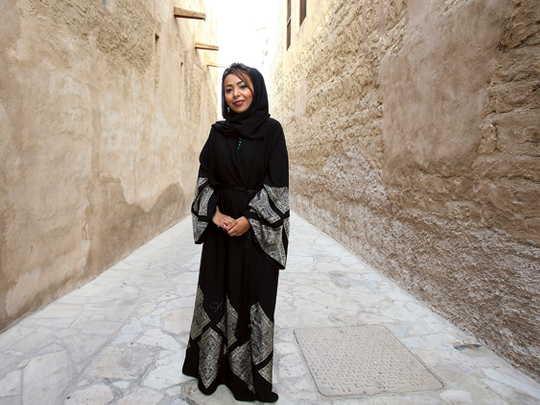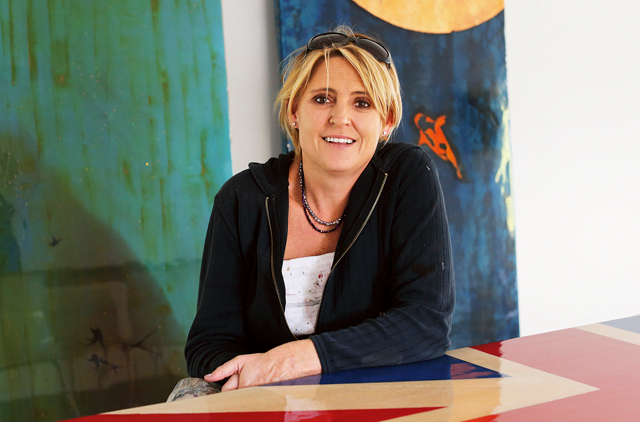
THE NONCONFORMIST
UAE national Ebtisam Abdul Aziz is a visual artist and a free thinker
“I was born in Abu Dhabi to a large family, with progressive and open-minded parents. Although my father managed the family travel agency, his real passion has always been art and travelling. My mother left school at age ten, but is an accomplished singer.
“My father wanted to bring up his children in his own way – removed from the constraints of his extended family – so, when I was about 12, we moved to Sharjah.
“I loved art at school and my teen years were spent drawing and painting. My father encouraged me, bringing special canvases, pastels and equipment from his travels. Sometimes I would stay up all night reading foreign art magazines – normally by torchlight so I wouldn’t get caught – absorbing concepts about sculpture and painting that were way beyond my 14 years.
“When I finished school, my highest grades were in mathematics. I loved art but hated the way it was never taken seriously. Even at university level, art just involved stitching and calligraphy, and the only job prospect was to become a teacher. As a woman in this fast-developing and exciting nation, I was too ambitious to settle for that. I wanted to make a difference. So I studied science and maths at university.
“While studying I stayed in the student accommodation, which had strict rules and a stern matron. I painted a mural – a self-portrait – on my bedroom wall. I was severely reprimanded and made to paint over it. It was rebellious perhaps, but it motivated me to enter an art contest, which I won, and got me back into art.
A change of course
“After university I studied at the Emirates Fine Arts Society in Sharjah and, in 2001, was hired as manager of Sharjah Ladies Club’s art centre – a position that I held for eight years. During this time I experimented with my own art, but often felt frustrated and lost in my paintings – as though my ideas were too big and there wasn’t enough room on the canvas to express myself.
I was interested in the conceptual art movement and followed with interest the work of fellow Emirati artists Hassan Sharif and Mohammed Kazem who use cloth, wire and other materials to present art as a statement rather than an object of beauty. Under their influence, I formed my own ideas using many disciplines including photography, video and even performance. I now feel as though I have found my calling in a combination of multidisciplinary and conceptual art.
My generation
“I believe true artists will express themselves using the tools of their time. Being a young Emirati woman, I see my generation as one of emancipation and change. To reflect this I use a mixture of technology, video, photography and modern mathematical elements. One piece I worked on between 2003 and 2005 explored the concept of humanity as being more than just a number.
I collected all my ATM and bank statements over two years with their dates, digital times and amounts. The sequence of numbers I collected became a kind of self-documentation that I then printed in green on to a black one-piece suit. I was photographed wearing it in the streets and malls of Sharjah, sparking interest and conversation.
“I am making a name for myself internationally, but as a Muslim woman, this type of artistic statement isn’t easy as society in the UAE can be conservative. But I feel strongly that my role as an artist is to question and stimulate society. I do meet with resistance – my father is proud of me, but others don’t understand. The most pressure I feel is the fact that I am unmarried. Society needs more time to accept that I am an artist first. Any man in my future must understand, appreciate and support this.”
Ebtisam is running a series of workshops at Abu Dhabi Festival later this month (abudhabifestival.ae). For more on her work, visit ebtisamabdulaziz.com.
THE CREATIVE WRITER
Author Kathy Shalhoub hid her love for creative writing behind an aptitude for science until adulthood
“I was raised in Lebanon during the civil war by a Polish father and Lebanese mother. War was a recurring theme throughout my childhood, causing frequent power outages, long periods of hiding in shelters during bombing episodes and strikes keeping us out of school. For a child this meant one thing – boredom. My mother taught English and creative dramatics and both my parents were avid readers, so our home was full of books on every subject imaginable. To relieve the boredom I read and eventually fell in love with the written word.
“When I was eight I ‘published’ my first book – a handwritten poem that I painstakingly illustrated and felt so proud of until my siblings found it. They teased me mercilessly and ripped it up. As an adult I now look back on that day as my ‘creative mortification’. I was so embarrassed that I shut down this creative outlet. I continued to write – poetry, stories and a personal journal – but I kept it all well hidden for fear of further humiliation.
“In Lebanon, great value is placed on careers in the fields of engineering, law and medicine. Anything creative was considered futile and sure to leave you penniless. So, aside from my secret journal writing, I disregarded any creativity and focused on the subjects deemed academic, eventually achieving one of the top grades in physics in my class.
“At 17 I left Lebanon and moved to New York to become an electrical engineer. Four years later, I was accepted into Massachusetts Institute of Technology and got my Masters in Ocean Engineering. My first job was as a research and development engineer working on underwater robots.
Change of path
“During this time I began to evaluate myself. I realised I was not the person I wanted to be. I felt too analytical, too methodical and nowhere near the fun, colourful person I believed I was. I started to travel and, with each new culture, I felt my creative floodgates open. “When I was 26, I moved to the south of France to help set up an ocean observatory and to complete my PhD. I started a blog to document my travel adventures for friends and family back home, but also to express a growing identity crisis I felt as an expat Lebanese.
I experienced such pleasure writing the blog; my creative side, crushed since I was eight years old, was resurfacing with vigour. Blogging felt like a lifeline from my prison of scientific journals and data analysis – my computer screen was my window of escape. “On one of my trips home, Christmas of 2006, I met my husband Elie, also a Lebanese engineer, who was living in Dubai. We fell in love and I moved to Dubai after persevering to finish my PhD (with honours!). We were married in 2009.
While pregnant with my first child, Dubai-based artist Lama Khatib Daniel encouraged me to compile my blog posts into a book that eventually became my first published work, Life as a Leb-Neh Lover. It was shortlisted at the 2011 International Book Awards in the best new non-fiction and multicultural non-fiction categories.
Bitten by the bug
“I’ve since departed entirely from science to concentrate on creative writing. It’s a challenge, but it feels wonderful. Writing is like a short-circuit between my hand and my true self, completely bypassing my scientific brain. When I write it’s always a surprise to discover what lies hidden inside me, but it feels right.
“Our second child was born 2011 and I’m currently working on a suspense novel, set in Lebanon, which is to be published later this year. Between being a mum and writing, I’m also training to be a creativity coach. I believe we are all creative. “My objective as a creativity coach is to give women and youth guidance in finding their own creative side. Through my own experience, I believe creativity and self-expression are the true conduits to happiness.”
Catch one of Kathy’s creative writing workshops at the Emirates Airline Literary Festival. For details, visit her website, www.kathyshalhoub.com.
THE FUNCTIONAL ARTIST
South African artist Candeta Beardsworth Bishop has gone from filmsets to tabletops
“I’ve known I wanted to be an artist since I was ten years old. I graduated from the Tshwane University of Technology in South Africa with a technical degree in special effects for film, television and theatre.
For the next ten years I worked as an artist on film sets... I spent a few months in Malaysia for the film Anna and the King, a period drama about the King of Siam and his forbidden love for a British governess. We decorated temples and built ornate horse carriages. I was also involved in creating an authentic colonial-style ranch house in the African bush for the filmset of I Dreamed of Africa.
“The most exciting thing about scenic art is being able to create an illusion, a fantasy land. The projects are large scale – not just houses but ships, palaces, cars, planes. The work is hands-on and physically demanding, something I still find immensely satisfying.
“Artistic work on filmsets overlaps with creating theme parks and exhibitions. In 2001 a Dubai-based architectural firm approached me to help create the European Renaissance theme for Mercato Mall. After that I worked on Ibn Battuta Mall, bringing the travels of the Arabian explorer to life. I was involved in many big projects across the city, including the Dubailand sales office and Sega Republic at the Dubai Mall. “In 2007 I met my Welsh husband in Dubai and we were married a year later.
Taking the leap
“The global financial crisis put a stop to themed developments, drying up future work for me. This was the catalyst I needed to make a change, so in 2009 I decided to go it alone as an artist. “At first I found it difficult to be without the direction I was used to – I floundered a bit, wondering where I should start and when I should stop. The force of my now unleashed creativity was initially overwhelming. But I gradually learned self-trust and started experimenting with large-scale mixed media canvases.
“My creativity started to spill over into new and used furniture we bought. One piece I started revamping was a dining table, which I treated like a huge canvas. At 2.5 metres and weighing 60 kilograms, it was heavy, physical work. Using a complex process of layering paint, oil glazes, various chemicals and interesting objects, I began exploring my thoughts and weaving a story into the tabletop. Once finished we ate off it and I loved the way it became a dinnertime conversation point; a functional piece of abstract art.
“For now I’ve decided to focus on tables as my creative outlet. They are made out of old weathered scaffolding planks that I choose because they have a certain character. No two tables are the same. Their uniqueness comes from detail such as wire and nails, gold and silver leaf, perhaps a butterfly or a fish.
“As I create the tables, I feel unrestrained and free to express myself in the way I want, following any path it takes me. On filmsets I used to work as part of a team with a defined brief. Now I relish being alone and controlling the entire process. I don’t feel compelled to make any profound statements through my tables; they are purely intended as an object of beauty and intrigue. Neither am I driven by sales. It’s the personal satisfaction I take pleasure in. Abstract art is my way of turning the mundane into something wonderful; giving spark to what is otherwise dull.
“I’m proud of my visual contribution to Dubai, but for now my creative journey has taken another turn. It feels like an exciting, unstoppable force. I’ve learned to enjoy it and go with it, never knowing where it will take me next.”
Candeta is represented by art agency Adam and Geisler. For details, visit adamandgeisler.com.













